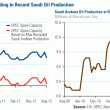Gold Market Radar (September 9, 2013)
For the week, spot gold closed at $1,390.62, down $4.53 per ounce, or 0.32 percent. Gold stocks, as measured by the NYSE Arca Gold Miners Index, lost 0.56 percent. The U.S. Trade-Weighted Dollar Index was essentially flat with a 0.08 percent gain for the week.
Strengths
- Net gold shipments to China from Hong Kong increased to 113 metric tons in July, up from 101 tons a month earlier. On average, premiums to attain physical delivery of gold were 2.1 percent higher than global markets. China’s total gold consumption this year may jump by 29 percent to reach 1,000 tons, overtaking India to become the world’s largest gold consumer.
- Gold rebounded on Friday as weaker-than-forecast gains in U.S. payrolls revived prospects for an extension of economic stimulus by the Federal Reserve, stoking demand for the metal as a store of value. Employers added 169,000 workers in August while Bloomberg’s survey called a gain of 180,000. Gold shed about $45 in the two days prior, as the Institute for Supply Management’s non-manufacturing index rose to 58.6 in August. The median forecast called for a drop to 55.
- Platinum ETF holdings rose 38 percent to a fresh record with South Africa’s NewPlat ETF becoming the largest platinum ETF with market share of 27 percent. In other South African news, some gold miners ended their strike after 48 hours and are heading back to work, bolstering confidence that the entire strike could soon be over. Pan African Resources and Village Main Reef both announced wage settlements with single-digit raises. Sibanye Gold said workers at its Kloof mine near Johannesburg ended a strike as well.
Weaknesses
- Holdings in the largest U.S. gold-backed exchange traded products dropped 1.8 metric tons for the week after rising in the previous three weeks.
- South African gold shares were under pressure for most of the week as uncertainty about the duration of the strike called by the National Union of Mineworkers, along with the quantum of a final wages settlement, weighed on investment sentiment. The National Union of Mineworkers said it wanted a 60 percent increase in base pay.
- The plunge in the rupee, paired with a surge in the local gold price in India, has finally triggered the selling of scrap gold. This eases a supply crunch caused from curbs on imports by the world’s largest consumer. Sellers of scrap have even taken a discount to tender their gold.
Opportunities
- A publication by PwC entitled “Deals in the Dumps: Global Mining Deal Mid-Year Report,” says that deal value fell 70 percent for merger and acquisition activity in the first half of the year. This dropped to $22.9 billion between January and June, compared to the same period last year. In total, there were 649 mining sector deals in the first six months, down 31 percent from the same period of 2012 when there was a total of 940 transactions. In the first six months of 2011 there were 1,371 mining deals.
- Deal activity has largely been stifled by companies unwilling to commit to new acquisitions in the shadow of billions of dollars of write-downs. Some companies have been opportunistic such as Alamos Gold with its purchase of Esperanza Resources for cash and a five-year warrant on the shares of Alamos. Such purchases are for relatively small companies that have been beaten up but still offer tremendous value. In another deal this week, Newmont Mining bought a significant stake in Novo Resources at a premium to the market.
- David Rosenberg of Gluskin Sheff has been in the deflation camp for quite some time, but now sees inflation more probable in the future. In his “Breakfast with Dave” publication from September 3, David states that the Fed is no longer pursuing price stability, which many officials actually believed was 1 percent on core consumer price trends just half a decade ago. He goes on to say, “now the Fed is de facto, telling us that it is going to tolerate, and in fact many of the FOMC members desire this, inflation heading up to 2.5 percent.” Low labor participation rates, combined with the mismatch between the skill set that employers need versus the skill set that is available, inflation may be hard to contain after such an unprecedented experiment in expanding the Fed’s balance sheet.
Threats
- The Securities and Exchange Commission (SEC) will rewrite its proposed rule requiring oil, gas and mining companies to disclose payments to foreign governments, rather than appeal a federal court ruling claiming the agency’s financial disclosure rule had “serious” problems. Federal District Judge John Bats ruled that the SEC misread a Dodd-Frank statute requiring mining companies to disclose what they pay foreign governments for mineral rights. By forcing companies to reveal foreign payments in countries where those nations prohibit such disclosure, the burden on completion and cost to investors drastically increases. Oxfam America announced that it joined U.S. senators and key investors to call the SEC to promptly re-issue the landmark oil, gas and mining transparency rules. The judge recognized that such disclosure is bad for business, and will likely drive investment away from countries that need such development for economic growth.
- According to forecasts compiled by Bloomberg, the twenty-largest mining companies by market value are set to spend about $244 billion on expansions through 2015, a 2.4 percent drop from the $250 billion in capital expenditure made in the previous three year period. Ivan Glasenberg, CEO of Glencore Xstrata, has called for austerity in the mineral markets to end an oversupply of metals. Investors including BlackRock, the world’s largest money manager, have been pressuring mining companies to boost shareholders’ returns and defer the construction of mines. This pressure comes from waning demand and declining prices which erode profits.
- Alaska Governor Sean Pamell ordered an investigation into the practices of the Alaska Department of Environmental Conservation’s Environmental Crimes Unit as well as the U.S. Environmental Protection Agency’s (EPA’s) Criminal Investigation Division. This investigation comes after armed government agents swooped in on 30 small-scale “mom and pop” placer gold mining operations along the Fortymile River near Chicken, Alaska. Chicken is a remote area close to the Canadian border with a population of 13. Placer miners are known to use primitive tools such as a shovel and a sluice box to sieve gravels within the stream. Clays are lifted off the bottom of the river but settle back into their natural surroundings. EPA agents claimed that the weapons and body armor that they used were necessary, as possible felony violations of the Clean Water Act could be taking place and that the Alaska State Troopers were concerned with “rampant drug and human trafficking going on in the area.” Trooper spokesman Megan Peters insisted that state troopers did not advise the EPA of dangerous drug activity in the area. “I am deeply troubled by the aggressive show of force and tactics employed by the EPA and other agencies,” said Alaska Congressman Don Young in a statement on Thursday.














